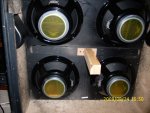OK, just got an empty 5150 cab for dirt cheap. Pretty beat up, but it's a project anyway so I don't really care.
A few questions:
There is no batting inside, and of the other pics I've seen, there never was supposed to be. Would it improve anything if I put some in? If so, where? Around the sides, sides and back, what?
The stiffener that goes in the center from front to back was just laying in the bottom and I can't tell how it was attached. I'm assuming then, that it's supposed to be glued?
I would like to make this have stereo capability, or if necessary, dedicated stereo. Do I need to put a baffle in to separate the sides?
I've seen guys put different sets of speakers in, 2+2, but if I want 4 different ones, how much is their different efficiencies going to muck up the situation?
More questions, but let's get through these first.
Also, there's a 99.9% probability that this will never be used live. Just me, recording at home. (Hmm, maybe I should start a website dedicated to...nah.)
A few questions:
There is no batting inside, and of the other pics I've seen, there never was supposed to be. Would it improve anything if I put some in? If so, where? Around the sides, sides and back, what?
The stiffener that goes in the center from front to back was just laying in the bottom and I can't tell how it was attached. I'm assuming then, that it's supposed to be glued?
I would like to make this have stereo capability, or if necessary, dedicated stereo. Do I need to put a baffle in to separate the sides?
I've seen guys put different sets of speakers in, 2+2, but if I want 4 different ones, how much is their different efficiencies going to muck up the situation?
More questions, but let's get through these first.
Also, there's a 99.9% probability that this will never be used live. Just me, recording at home. (Hmm, maybe I should start a website dedicated to...nah.)


